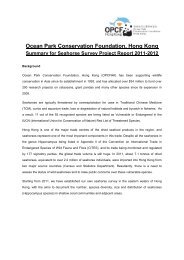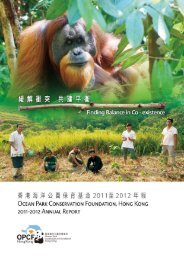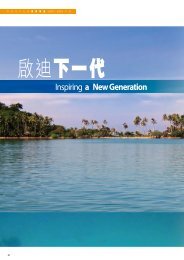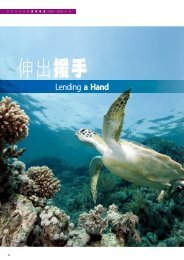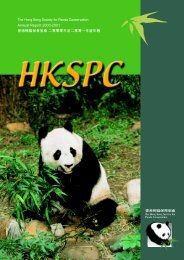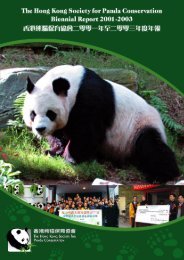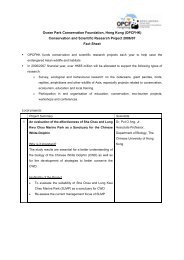Summary of OPCFHK Seahorse Survey Project Report (2011-2012)
Summary of OPCFHK Seahorse Survey Project Report (2011-2012)
Summary of OPCFHK Seahorse Survey Project Report (2011-2012)
You also want an ePaper? Increase the reach of your titles
YUMPU automatically turns print PDFs into web optimized ePapers that Google loves.
Ocean Park Conservation Foundation, Hong Kong<br />
<strong>Summary</strong> for <strong>Seahorse</strong> <strong>Survey</strong> <strong>Project</strong> <strong>Report</strong> <strong>2011</strong>-<strong>2012</strong><br />
Background<br />
Ocean Park Conservation Foundation, Hong Kong (<strong>OPCFHK</strong>) has been supporting wildlife<br />
conservation in Asia since its establishment in 1993, and has allocated over $34 million to fund over<br />
290 research projects on cetaceans, giant pandas and many other species since its expansion in<br />
2005.<br />
<strong>Seahorse</strong>s are typically threatened by overexploitation for uses in Traditional Chinese Medicine<br />
(TCM), curios and aquarium trade, loss or degradation <strong>of</strong> natural habitats and bycatch in fisheries. As<br />
a result, 11 out <strong>of</strong> the 55 recognized species are being listed as Vulnerable or Endangered in the<br />
IUCN (International Union for Conservation <strong>of</strong> Nature) Red List <strong>of</strong> Threatened Species.<br />
Hong Kong is one <strong>of</strong> the major trade centres <strong>of</strong> the dried seafood products in the region, and<br />
seahorses represent one <strong>of</strong> the most important components in this trade. Despite all the seahorses in<br />
the genus Hippocampus being listed in Appendix II <strong>of</strong> the Convention on International Trade in<br />
Endangered Species <strong>of</strong> Wild Fauna and Flora (CITES), and its trade being monitored and regulated<br />
by 177 signatory parties, the global trade volume is still huge. In <strong>2011</strong>, about 7.1 tonnes <strong>of</strong> dried<br />
seahorses, equivalent to over 2.2 million <strong>of</strong> seahorse individuals, were imported into Hong Kong from<br />
two major source countries (Census and Statistics Department). Resultantly, there is a need to<br />
assess the status <strong>of</strong> wild seahorses and to raise public concerns over these vulnerable species.<br />
Starting from <strong>2011</strong>, we have established our own seahorse survey in the eastern waters <strong>of</strong> Hong<br />
Kong, with the aims to document the number, species diversity, size and distribution <strong>of</strong> seahorses<br />
(Hippocampus species) in shallow coral communities and adjacent areas.
Methodology<br />
Previous sighting records <strong>of</strong> seahorses from Hong Kong Reef Check were obtained from Agriculture,<br />
Fisheries and Conservation Department (AFCD) and Reef Check Foundation Hong Kong as<br />
reference for the site selection. A total <strong>of</strong> 31 sites (24 Hong Kong Reef Check sites and 7 additional<br />
sites) were visited during September <strong>2011</strong> and October <strong>2012</strong>, and an underwater visual census with<br />
GPS density survey was conducted at the selected sites. Upon sighting <strong>of</strong> a seahorse, time and GPS<br />
location, generated by a synchronised watch with GPS, were recorded.<br />
The species, body<br />
measurements, sex and the substrate to which the seahorse was attached were also noted.<br />
Researchers took photos for record. These provide useful biological and ecological information <strong>of</strong> the<br />
seahorses inhabiting the local waters.<br />
Divers’ sighting records were also collected to supplement the survey results on the distribution <strong>of</strong><br />
seahorses in Hong Kong waters. Photos <strong>of</strong> seahorses from recreational divers were collected as a<br />
pro<strong>of</strong> <strong>of</strong> the sightings, whilst sighting records without photos were disregarded.<br />
Results<br />
A total <strong>of</strong> six individual seahorses, comprising one male and five females belonging to one species,<br />
yellow seahorse (Hippocampus kuda), were observed at two diving sites in Sai Kung waters during<br />
the survey. Their overall height (from "crown" to tip <strong>of</strong> the tail) ranged from 40 to 154mm. As the<br />
survey will be continued in 2013, more information on distribution, number and density <strong>of</strong> seahorses<br />
in the local waters will be collected and analysed.<br />
Divers’ records suggested seahorses were seen in 6 other sites in Hong Kong waters. <strong>Seahorse</strong>s<br />
were not found in 3 <strong>of</strong> these, and the remaining 3 sites are planned to be surveyed in 2013.<br />
<strong>Summary</strong> & next plan<br />
As the number <strong>of</strong> seahorses found in this study was very low, we would continue the survey in 2013<br />
to cover more sites within the eastern waters <strong>of</strong> Hong Kong. More surveys are needed for sites with<br />
previous to verify their presence.<br />
Further in-depth studies are in plans for 2013 to understand the survivorship, growth, home range,<br />
and site fidelity <strong>of</strong> the seahorses by tagging each individual seahorse found in the survey. Through<br />
regular monitoring <strong>of</strong> the tagged individuals, more information on the biology and ecology <strong>of</strong> local<br />
seahorses could be revealed.
Figure 1 The photos <strong>of</strong> the seahorses found in this survey period<br />
- The End -




